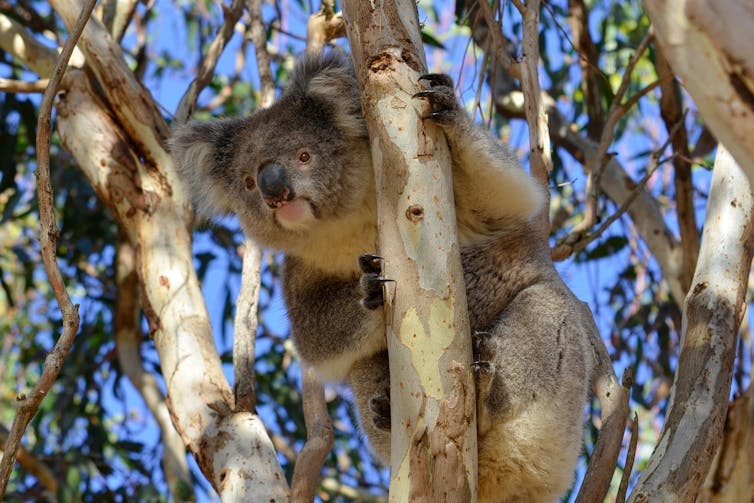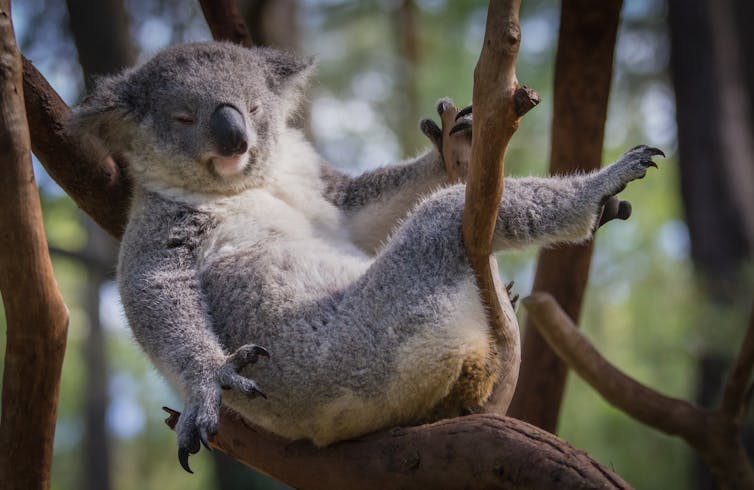Koalas sniff out juicy leaves and break down eucalypt toxins – it's in their genome
- Written by Jenny Graves, Distinguished Professor of Genetics, La Trobe University
News is out today that the entire genome of the koala has been sequenced. This means we now have a complete read-out of the genes and other DNA sequences of this iconic marsupial mammal.
Knowing the full set of koala genes deepens our knowledge of koalas (and other Australian mammals) in many ways. Now we can understand how koalas manage to survive on such a toxic diet of gum leaves. Now we can follow the fortunes of historic koala populations and make good decisions about how to keep remaining koala populations healthy. Now we have a new point of comparison that we can use to understand how the mammal genome evolved.
This is important for science – but also economically. Koalas are incredibly well loved, with their baby-faces, shiny noses and big fluffy ears. Millions of visitors line up each year to spot them snoozing in gum trees – indeed, they are worth A$3.2 billion in tourist dollars.
Koalas are listed as a vulnerable species in some parts of Australia, affected by habitat destruction, disease and other stresses.
Read more: Drop, bears: chronic stress and habitat loss are flooring koalas
The koala genome
Koala DNA was sequenced with new “long-read” technology that delivers a complete and well-assembled genome. As far as quality of the read-out goes, it’s as good as the human genome, with continuous sequences now known over huge (almost chromosome-scale) spans. New technology enabled us to achieve this at a tiny fraction of the $2.7 billion it cost to sequence the first human.
The obtained koala genome sequence is much better quality than that for other sequenced marsupials – opossum, tammar wallaby and Tasmanian devil – and will really help us to assemble and compare genomes from all marsupials.
The koala has a genome a bit bigger than that of humans, with 3.5 billion DNA base-pairs. This amounts to about a metre of DNA, which is divided and packaged into eight large bits that we recognise as chromosomes.
Read more: Is your genome really your own? The public and forensic value of DNA
An animal has a set of chromosomes from mother and a set from father, so koalas have 16 large chromosomes in each cell. This is similar to other marsupials; as a group they seem to have a low chromosome number and a very stable genome arrangement. In placental mammals the number and arrangement of chromosomes is much more varied: for example, humans have 46, and rhinos 82 chromosomes.
The source of junk DNA
New findings from the koala genome help us to understand how mammal genomes evolved and how they work.
A lot (sometimes more than 50%) of animal genomes seem to be “junk DNA” – these are repeated sequences, many deriving from ancient viral infections. The koala, uniquely, seems to be in the middle of one such invasion. A DNA sequence derived from a retrovirus is present in different numbers and sites in different koala populations, testifying to its recent movement and amplification. This helps us learn how the genomes of humans and other mammals got so puffed up with junk DNA.
Like the human genome, the koala genome contains about 26,000 genes. These are stretches of DNA that code for or control proteins. Indeed, most koala genes are present in humans and other mammals – these are the same genes doing the same basic jobs in different animals.
So why is it important to sequence different species if their genomes are so similar? Well, it’s the special genes that have evolved to adapt the koala to its unique lifestyle that give us new and valuable information.
Read more: Proposed NSW logging laws value timber over environmental protection
How to survive on gum leaves
How koalas exist on an exclusive low-calorie and toxin-laced diet of eucalyptus leaves has been somewhat of a science mystery.
The genome provides answers. The koala has multiplied a family of genes that code for enzymes (members of the cytochrome P450 family) that break down the toxins of gum leaves. Evolution of these additional gene copies has enabled the koala to outstrip its competition, even at the cost of sleeping most of the day.
The genome also gives us clues to the koala’s picky eating habits. The koala genome contains many additional copies of genes that enable them to taste and avoid bitter flavours and even to “smell” water and choose juicy leaves (they don’t drink water).
 Koalas have 16 chromosomes per cell.
chrisfithall/flickr, CC BY
Koalas have 16 chromosomes per cell.
chrisfithall/flickr, CC BY
The genome also gives us new information about how koalas develop. Like other marsupials, they are born about the size of a pea, and complete most of their growth and differentiation in the pouch. Developing koalas are nurtured by milk with a complex composition that changes with the stage of development.
Read more: Breast milk banking continues an ancient human tradition and can save lives
Saving an iconic Australian
Managing koala populations is very fraught, and there has long been a need for a holistic, scientifically-grounded approach to koala conservation.
Today’s koalas are the “last stand” of the marsupial family Phascolarctidae – and the koala genome contains new information about this evolutionary history. It also tells us that koala populations peaked about 100,000 years ago, then plunged to about 10% of their numbers 30-40,000 years ago, at the same time that the megafauna became extinct. This population was fairly stable until European settlement, when it plunged again to its present numbers (about 300,000).
Koalas once occupied a swathe of timbered habitat from Queensland to South Australia; now, only fragmented populations survive in the south. These are intensively managed, and small numbers of koalas are translocated to other sites, producing dangerously inbred populations. Bizarrely, one of the greatest problems is overbreeding in isolated populations – for example, on South Australia’s Kangaroo Island – which leads to animals eating themselves out of house and home.
The enemies of koalas in the north are habitat destruction and fragmentation by urbanisation and climate change.
Read more: Did sex drive mammal evolution? How one species can become two
The koala genome paper reports sequence comparisons of different populations and identifies barriers to gene flow. With the information from the koala genome, we can now monitor genetic diversity in the surviving populations, and maximise gene flow between connected populations.
 Koalas are the sole surviving member of the Phascolarctidae marsupial family group.
Photo by Holger Link on Unsplash, CC BY
Koalas are the sole surviving member of the Phascolarctidae marsupial family group.
Photo by Holger Link on Unsplash, CC BY
Maintaining genetic diversity is important because different animals can mount different responses to environmental threats and diseases such as chlamydia, a bacteria that affects koala reproduction and eye health.
The koala genome provides us with information about the immune genes of the koala, and the changes in activity of these genes in infected animals. This will help us understand the different responses of animals, vital for developing vaccines and treatments.
The koala genome also identifies powerful anti-bacterials in milk that protect the baby koala from disease – and may provide humans with the next generation of antibiotics.
So sequencing the koala genome is good for science and good for koalas, an iconic species at the top of the tree for conservation efforts.
Authors: Jenny Graves, Distinguished Professor of Genetics, La Trobe University





